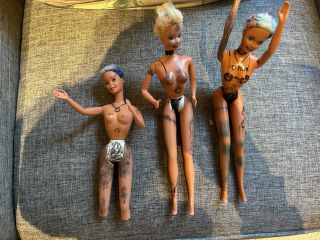Fantasies
You’ve Come a Long Way, Barbie!
From fantasy to reality and back again.
Posted September 4, 2023 Reviewed by Hara Estroff Marano
Key points
- Fantasy play feeds back into reality.
- Barbie, the billion-selling doll, spawns disputes about body image.
- Barbie tracked extraordinary changes in thinking about femininity and feminism.

Removed at least four steps from reality, Barbie, a billion-seller, began as a toy manufacturer’s notion of a little girl’s fantasy of the life that a high-style fashion model might lead.
Venerable in her seventh decade now, and having appeared in many hundreds of incarnations—including a paleontologist, a rapper, a noodle barista, a panda rescuer, a paratrooper, a game-developer, a President (let’s not forget that one), and a cat-burglar (who knew?)—Barbie clicked because she has reflected the widening aspirations for women in the years since 1959.
But Barbie’s multiplying reflection appears as if glimpsed through little girls’ eyes, intermittently, in a mirror that their older sisters had commandeered.
From “Working Girl” to Career Girl
Barbie’s image inspired a mix of love, the sense of immanent opportunity, and consternation from the first. Ruth Handler, a manager at Mattel, who had vacationed in post-war Germany, brought back with her several “Bild-Lilly” figurines—saucy gag gifts that might reasonably be called action figures—3D versions of a comic-book “working-girl” sold to grown men in tobacco shops.
Bild Lilly featured the sultry sidelong glance that emerged from below arched, plucked brows, part Lauren Bacall, part Sophia Loren. (We might say part Paris Hilton and part Dua Lipa now.) The first Barbie, iconic in a zebra-striped swimsuit and open-toed pumps, was a dead ringer for her German inspiration.
Handler, who wisely understood that “little girls wanted to pretend to be bigger girls,” knew that she needed to overcome the skepticism of male executives in the toy industry, mossbacks wedded to the prescriptive inevitability of baby-doll play. Handler was also keen to distance the doll from its streetwalker provenance,and so fashioned a wholesome American back story.
Thus, Bild Lilly morphed into the sweet, corn-fed “Barbara Millicent Roberts” who attended Willows High School in bucolic Willows, Wisconsin.
You’ve Come a Long Way, Barbie
Still, over the next decades, this curvaceous blonde beauty repurposed to the American heartland followed, paced, and then eventually led the democratic trend toward inclusion as Barbie appeared in Black, Asian, Inuit, Irish, Greek, Korean, Polynesian, Mexican, Puerto Rican, pre-contact Incan, and ancient Egyptian avatars with diverse skin tones.
Over time, Barbie also outgrew the original, statuesque measurements that feminist critics called “impossible”—these roughly scaled up to 40” x 18” x 32”—as she appeared in multiple new and more realistic body-positive types that ranged from “curvy” to “petite.”
In 2019 even more basic changes saw Barbie appear in several gender-neutral iterations that the company described as more “relatable” than “aspirational,” so that “kids can be kids and toys can be toys.” These slim-hipped smooth-chested “youthful” dolls can be accessorized with wigs or short hair and skirts or pants, depending. And the effect of this remarkable self-assessment was to depressurize Barbie for sub-teen players.
And Now the Movie…
A feedback loop from marketing opportunity to fantasy play to real-life ambitions and back to gender construction theory and on to cultural politics in the real world powers the sly live-action musical comedy that debuted worldwide to sellout audiences.
In the film, Barbie’s many incarnations populate an ideal alternative matriarchy with Barbie’s Dream House as its centerpiece. In this parallel pink Barbieland, the President is Barbie, and all nine members of the Supreme Court are Barbies. True to the product line, all the other authority figures—the lawyers, the doctors, the smiling traffic cops, as well as the newest Nobel Prize winner—are also versions of Barbie. Ken, a long-term accessory and beach bum, exists to please, and his happiness in this fantasy, alas for him, resides only within Barbie’s gaze.
Barbie, of course, is perfect and perfectly happy. Barbieland is perfect. According to my note scribbled in the dark theater, the perky optimist declares: “It is the best day ever. So was yesterday. And so is tomorrow, and every day from now until forever!”
Subversion as the Real World Leaks In
But this utopia is ripe for subversion when a smidgeon of reality leaks in from outside to highlight the dependent, fragile relationship of fantasy to reality, of Barbieland to the real world.
This Barbie, wryly identified as Stereotypical Barbie, the original that we know best, begins to be haunted by thoughts of mortality. Reality sets in, worryingly. As her feet flatten and she notices incipient cellulite, she begins to experience an existential crisis. Like Pinocchio, the Velveteen Rabbit, and Toy Story’s Woody, Stereotypical Barbie cannot make things right until she undertakes the hero’s journey from the imaginary toy world to reality and back again. Fittingly, she starts off in her pink 1960s Corvette to find the source of the trouble.
And the source of her distress? The tension between a sorely beset real-world mother, Gloria, (who happens to work at Matell!) and a bright but bratty preteen daughter, Sasha, that spills over into Barbieland as the two face the trials of adulthood and adolescence. (Gloria’s soliloquy about the contradictory demands of womanhood, “It’s literally impossible to be a woman,” is worth the price of admission.)
When Sasha and her friends dress Barbie down for the unrealistic body image she sells and for her complicity in sexualized patriarchal consumerism, Barbie, wounded and confused by the post-feminist rejection, just can’t believe it, because after all, isn’t she, along with the rest of her talented incarnations, all about advancing female agency?
Can Barbie Be Weird?
The film rewards audiences with several cleverly drawn comic characters. For me, the cleverest is Weird Barbie. Weird Barbie is a wise outcast—cast out because she has been mangled, drawn upon with felt tips, dressed haphazardly, and barbered unmercifully as so many hand-me-down Barbies were in the real world. Weird Barbie admits that she has a “funky haircut” and “smells like basement.” “I had a Weird Barbie!” Gloria says when they meet, “you make them weird by playing too hard.”
It is Weird Barbie, the oracle in the hero’s journey, who in her scruffy state easily understands what Stereotypical Barbie struggled to learn; that perfection is neither attainable nor desirable. Armed with this insight, she devises a plan to restore order and a measure of gender equality in a Barbieland turned upside down.
But it is also Weird Barbie who, back in our real world, proves the genius of the marketplace in digesting challenges to its dominion. Closing the feedback loop from fantasy to fantasy-play and back to marketing, the toy company announced a limited-edition Weird Barbie doll (inked up and wearing snakeskin boots) that rapidly sold out in pre-order.
References
Ruth Handler, Dream Doll, (1995);Sarah Strohmeyer, “Barbie Banned in Vermont,” Salon, (Nov. 26, 1997); Ophira Edut, Adios Barbie: Young Women Write About Body Image and Identity (1998); Stacey Handler, “Barbie my Flawless Sister,” in The Body Burden: Living in the Shadow of Barbie, (2000); Tina Rosenberg, “For a More Natural Look, Barbie Getting Wider Waist, Smaller Bust,” Chicago Tribune, (November 18, 1997).
Scott G. Eberle, Classic Toys of the National Toy Hall of Fame, (2009);




